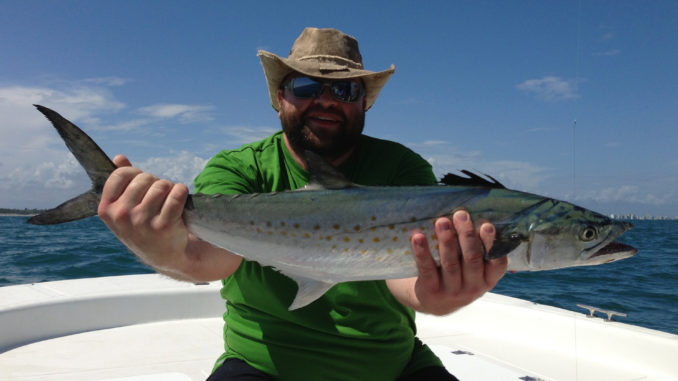
choolies show up first in nearshore Grand Strand waters, but big Spanish mackerel aren’t far behind.
May, the fifth month, is the true beginning of warm weather in South Carolina. It’s May Day, with flowers blooming and new life erupting across the state, for horse-racing fans, it’s the Kentucky Derby. But anglers in the Palmetto State chase a different kind of fortune, while wearing less frilly attire. May is the Spanish mackerel derby, a rite of passage along the southern end of the Grand Strand.
Big schools of Spanish mackerel blanket the nearshore grounds from just behind the breakers out to the last shimmering sight of land some 15 miles off the beach. From small, schooling fish to the solitary jumbos, anglers can encounter these powerful fish on light tackle almost anywhere. The combination of warm water and a hoard of baitfish arriving create a perfect scenario for catching a box-full of Spanish mackerel on the eve of summer.
“The Spanish start showing up in April to feast on glass minnows close to the beach, but they are mostly small fish, between 15 and 16 inches long,” said Capt. Jason Burton for Fly Girl Charters in Murrells Inlet. “It doesn’t take very long to get a limit in the early part of the season.”
Capt. J Baisch of Fishfull Thinking Guide Service has the same things on his mind.
“From the jetties out to 40 feet is the best place to find Spanish in the early part of the season,” said Baisch. “You want to stay on the shallow side, because the shallow water warms up first and attracts the bait.”
It is not until a little later that bigger Spanish show up targeting a different type of food source. As the water heats up through May and into June, waves of baitfish show up close to shore, and that really fires up the mackerel. Burton gets excited about these slender rockets when the real buffet shows up this month.
“In May, the schools of mullet and menhaden return, and the Spanish start packing on the pounds,” Burton said. “We start catching jumbos in the late spring and through the rest of the summer towards fall and the mullet run.”
During the spring and summer, Spanish mackerel and just about every other nearshore pelagic fish will be tailing pods of baitfish. It’s not uncommon to find Spanish crashing bait just about any time of day, within a 20-minute ride from the inlet and its jetties.
Burton finds mackerel around places with submerged structure or anything that concentrates bait.
“While we normally look for them at the jetties, along the beach and at the nearshore reefs,” he said, “Spanish can show up just about anywhere within 15 miles of shore. We always pay close attention to the birds to help us find a school of feeding fish.”
Spanish mackerel, king mackerel, bonito and other top predator fish provide a service to the avian community bringing their dinner to the surface. Spanish surround schools of baitfish and push them to the surface during feeding intervals, and birds , rely on the feeding frenzies to bring food right into their grasp. Look for birds picking at the surface from a distance and don’t be scared to accelerate towards an actively feeding school.
“There are a lot of days we never make it to our intended reef. We will short stop on a pod of birds and start catching Spanish on every cast,” Burton said.
Nevertheless, the surface-feeding frenzy never lasts long before the school retreats to the protection of the sea floor. Baisch strictly patrols pods of bait scattered along the beach, at the Three Mile and the other reefs close to Murrells Inlet.
“Work the schools of menhaden and glass minnows until you find a group of them, and some of the bait pods will have bluefish all over them. You just have to move around until you find a school with Spanish,” he said.
With Spanish crashing schools of baitfish and just about any kind of fishy looking carrot will gain the attention of a hungry fish. Trolling speed, however, will be drastically different depending on the type of lure or bait used.
Any time an artificial lure is used for Spanish mackerel, the throttle is engaged on the swift side, but live bait requires a turtle-slow speed.
Both Baisch and Burton will pull a typical Christmas tree rig set up with a small, No. 00 Clark Spoon pulled behind a small, No. 1 planer, fast enough to put a strong bend in the rod. Baisch will often pull up to schools just behind the breakers and burn a small crankbait or heavy casting spoon through the fish. Spanish look for their dinners trying to get away from them, so the high-speed retrieve and high trolling speeds will trigger a strike.
When live bait becomes available, a downsized king mackerel rig can replace the spoons and planers. Burton gets excited when the first menhaden show up, because he knows the big fish will soon be on the end of his line.
“I begin slow-trolling live bait just as I would for king mackerel, using 2-hook rigs with small, No. 6 hooks and light, 20-pound Seven Strand leader,” Burton said. “We try to target the bigger Spanish when we switch to live bait.”
For the most part, Burton also shifts his location to find the larger-sized fish.
“The concentration of bait is greater at the nearshore reefs, and the fish are much bigger there,” he said. “We troll menhaden at the reefs, barely kicking the motor in and out of gear, just enough to keep them from twisting.”
Big Spanish cannot resist the oily morsels swimming around their dinner table, and to sweeten the pot, Burton and Baisch catch a few extra buckets of menhaden for chum.
“We use anything we can get our hands on to chum, but mullet and baby menhaden work great. Heavy chumming will keep the fish in a feeding frenzy and right behind the boat,” Burton said.
Anglers can expect to catch Spanish through the summer and early fall until the bait leaves. Even though the warm air and the sweet smells of springtime bring many people to the beach, the water temperatures are still lagging a little behind, but not the fishing. Anglers can catch a limit of Spanish mackerel in no time, with some citation-sized fish in the mix.
DESTINATION INFORMATION
HOW TO GET THERE — Murrells Inlet is on the southern tip of the Grand Strand, easily accessible from the public boat ramp on US 17 Business, just south of the heart of Murrells Inlet’s famous restaurant district and Crazy Sister Marina. Spanish mackerel are found along the beachfront, at the Murrells Inlet jetties, and at the nearshore reefs in waters no deeper than 40 feet deep. Some of the best fishing is in waters 15 to 20 feet deep. As a general rule, Spanish mackerel will associate with structure like Myrtle Beach Rocks, the jetties and the many artificial reefs within 15 miles of shore, including the Paradise Reef, Pawley’s Reef, North Inlet Reef, 10-Mile Reef, and 11-Mile Reef. Look for birds diving to give away their locations. The Spanish will push the bait up to the surface and the birds will dive down and pick anything they can get.
WHEN TO GO — Spanish mackerel show up in large schools of mostly smaller fish in April. As the water warms and more baitfish show up, bigger fish arrive, and the bite will continue into the fall, when the water temperature starts to drop. As soon as the mullet and menhaden clear out in the fall, the Spanish will follow them.
TACKLE/TECHNIQUES — Both baitcasting and spinning gear perform well for trolling, but for casting, spinning gear with a high-retrieve ratio is preferred for the fast retrieves required. Rods should be 6-foot-6 to 7-foot for the long casts often required. Braided line from 15- to 30-pound class is preferred, but a heavy monofilament or fluorocarbon leader of no less than three to four feet is recommended between the running line and the lure. When trolling, pull No. 00 Clark Spoons, often behind a No. 1 planer. For casting, small crankbaits such as Yo-Zuri Crystal Minnows or casting spoons can be effective on a high-speed retrieve. When menhaden show up inshore, they can be fished on a small version of a king mackerel-style live-bait rig.
GUIDES/FISHING INFO — Jason Burton, Fly Girl Fishing Charters, 843-798-9100; J Baisch, Fishfull Thinking Guide Service, 843-902-0356, www.fishthinkguidesc.com; Pawley’s Island Outdoors (843-9790-4666, Perry’s Bait & Tackle, 843-651-2895.
ACCOMMODATIONS — Murrells Inlet Hampton Inn, 843-651-6687; Myrtle Beach Area Convention and Visitors Bureau, www.visitmyrtlebeach.com; South Carolina Association of Visitors Bureaus, www.discoversouthcarolina.com.
MAPS — Navionics, 800-848-5896, www.navionics.com; SeaLake Fishing Guides, 800-411-0185; www.sealakeusa.com; Waterproof Charts (Nearshore No. 98), 800-423-9026, www.waterproofcharts.com.

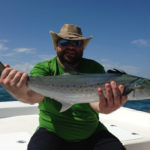
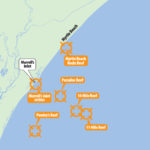
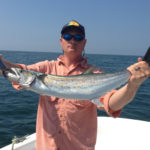
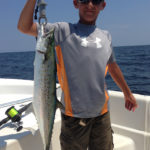

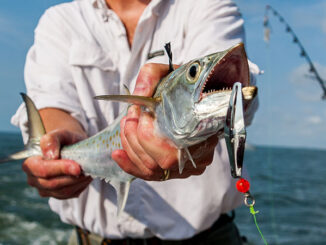

Be the first to comment